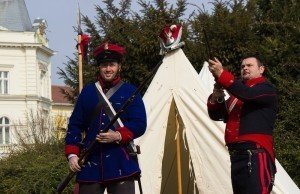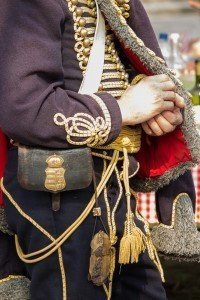March 15th and Hungarian Identity: thoughts from an outsider

“West County DUBLIN in 0ctober 1956 would seem an unlikely hotbed of indignation at the Russian response to the Hungarian uprising of that same year. I can still feel the rage at what I saw on our Sunday newspaper that morning. Unfortunate Budapest civilians lay scattered inside and outside trolley cars.
 For this 6 year-old, black and white photography deepened the horror of pooling blood and scattered body parts. I imagined each one falling under invading hails of arrogant hostility. One man in particular was spread eagled on a trolley stairway. Someone’s father, brother, husband, who had dodged World War2 a few years earlier, pulled me in to a deep, deep indignation. He has me still witnessing today to the world’s ongoing cries for justice around countless such scenes.
For this 6 year-old, black and white photography deepened the horror of pooling blood and scattered body parts. I imagined each one falling under invading hails of arrogant hostility. One man in particular was spread eagled on a trolley stairway. Someone’s father, brother, husband, who had dodged World War2 a few years earlier, pulled me in to a deep, deep indignation. He has me still witnessing today to the world’s ongoing cries for justice around countless such scenes.
My revulsion as I knelt on a kitchen chair over those images recurs again and again. With each newscast, in the many images that pepper countless war zones in our media today, I recall once more my own loss of innocence in October ’56.”
The above quote is excerpted from a piece written by my father. I remember him recounting this story to me after my first trip to Hungary. It’s stayed fresh in my mind since.
Over the years I’ve struggled to comprehend the Hungarian psyche. The more I research Hungarian history, language and politics, the more I find myself lost in a whirlpool of complex realities. It’s likely I’ll never peel back the onion-like layers of Magyar identity. And I accept that. Every nation has a complicated and tumultuous past and being a crossroads between east and west, Hungary has undoubtedly had its share of character building misfortune.
After my first visit in 2005 I had so many questions about Hungary. As I remember, my wife was even quite annoyed with my constant curiosity. Knowing next to nothing besides a bit of Austro-Hungarian Empire history, I was fascinated by the unique language and origins of this culture I was now married into.
I read about the 9th century migration of the Seven Magyar Tribes led by Árpád into the Carpathian Basin, the foundation of the Kingdom of Hungary by St. István in 1000 AD, and the eventual Ottoman occupation over much of the country from 1541 to 1699.
During the Ottoman Turk rule, portions of Hungary were also governed by rivals King Ferdinand of Austria and the Hungarian King János Szapolyai. The Habsburgs were indifferent to the Magyar struggle and uninterested in ousting the Ottomans, while the Hungarians were obviously adamant about expelling their occupiers. This led to a period of instability and constant conflict that weakened both the population and culture of the ethnic Magyars.
By 1686 the Hungarians, along with an international force, began reclaiming the rest of Hungary from the Turks. The Ottomans were decisively defeated in the second battle of Buda in 1686 and in the second Battle of Mohacs in 1687. Hungary was once again in western hands.
 What followed, however, was yet another repressive regime under the Habsburgs. With the Turks gone, the opportunistic Austrians began seizing property. King Leopold I governed his “Royal Hungary” from Vienna, and while Hungary wasn’t officially part of the Austrian Empire, it was ruled as though it were. Hungarian frustration grew, and 1703 marked the start of an eight year period of uprisings under the leadership of Ferenc Rákóczi. The revolts were predictably quelled and another period of political turmoil ensued, with Hungarians pushing for reforms while Austria approved and revoked such revisions with impunity.
What followed, however, was yet another repressive regime under the Habsburgs. With the Turks gone, the opportunistic Austrians began seizing property. King Leopold I governed his “Royal Hungary” from Vienna, and while Hungary wasn’t officially part of the Austrian Empire, it was ruled as though it were. Hungarian frustration grew, and 1703 marked the start of an eight year period of uprisings under the leadership of Ferenc Rákóczi. The revolts were predictably quelled and another period of political turmoil ensued, with Hungarians pushing for reforms while Austria approved and revoked such revisions with impunity.
In 1848, as revolution sparked in Paris and Vienna, Lajos Kossuth publicly demanded the passing of the March Laws and the formation of an independent Hungarian state. And on March 15th 1848 the revolution began in Pest. The revolt gained steam and by April 1849 the country was fully under Hungarian control. But the Habsburgs skillfully recruited the Croatian army under Jelačić to attack from the south. And while the Croats were defeated, the Habsburgs also partnered with the Russians, who attacked from the north and ultimately extinguished Hungarian hopes for independence.
Kossuth escaped into present day Bulgaria, but 13 generals known as the “13 Martyrs of Arad” were handed over to the Austrians and executed on October 6, 1849 in Arad (now a city in Transylvania). It’s said that Austrian officers clinked their beer mugs together and drank in celebration of the Hungarians defeat. Today, it’s still considered bad manners in Hungary to toast with beer.
 The 20th century was also unkind to Hungary. Being on the losing side of WWI and the subsequent Treaty of Trianon were catastrophic. Again in WWII, as a German ally, Hungary suffered the loss of nearly a million people and mass destruction of its cities. The ensuing Soviet occupation lasted 45 years and the failed 1956 Hungarian Revolution made headlines around the world, as evidenced by the introductory quote from my father. The USSR collapsed in 1991 but its reverberations and consequences are long lasting and deep. Of this I probably don’t need to tell you.
The 20th century was also unkind to Hungary. Being on the losing side of WWI and the subsequent Treaty of Trianon were catastrophic. Again in WWII, as a German ally, Hungary suffered the loss of nearly a million people and mass destruction of its cities. The ensuing Soviet occupation lasted 45 years and the failed 1956 Hungarian Revolution made headlines around the world, as evidenced by the introductory quote from my father. The USSR collapsed in 1991 but its reverberations and consequences are long lasting and deep. Of this I probably don’t need to tell you.
Thick clouds were beginning to clear as I drove towards downtown Miskolc. Normally bustling streets were still, empty; shops all over town were closed for the national holiday. The lack of traffic made this city of 170,000 feel like a village. As I neared the baroque and neo-classical buildings of the city center, the Avas Tower and the yellow bell tower of the Miskolc Evangelical Church soared into patches of blue sky.
When I left our house 15 minutes prior, Orban Viktor was on TV, in the middle of his speech to a large crowd in Budapest. Celebrations commemorating the March 15th 1848 Revolution were taking place simultaneously all over the country. Part of me wished I was in the Hungarian capital.
I parked my car near Szent István Square and walked towards the crowd. Men in vintage military uniforms held out old rifles and sabers for children. Their eyes lit up with wonder. I made my way across the grassy plaza towards a row of craft and souvenir sellers. Stalls displayed the folksy style I’ve come to expect and love at Hungarian events. Hand carved wooden bowls, trays and oversized utensils were spread across tables. Unique bird houses and stylish glassware featuring the Hungarian coat of arms lined shelves.
 Well dressed and groomed locals strolled alongside the poorer and unkempt. Yet all wore their cockade of red, white and green—the colors of the Hungarian flag—pinned to their left breast. Children played with wooden games in the grass and a man pushed around a ride made of wood, rope and spinning wicker baskets filled with giggling toddlers. A statue of Szent István looked on.
Well dressed and groomed locals strolled alongside the poorer and unkempt. Yet all wore their cockade of red, white and green—the colors of the Hungarian flag—pinned to their left breast. Children played with wooden games in the grass and a man pushed around a ride made of wood, rope and spinning wicker baskets filled with giggling toddlers. A statue of Szent István looked on.
On the other side of the market stalls, down a small embankment, I encountered a group of horses. They were tied into a makeshift corral of trees and rope. Elegant brass stirrups hung down from their leather saddles. Behind the trees a group of men sat at a table. They wore vintage blue uniforms with gold embroidery. I imagined they had just won a battle and were celebrating their victory. There was a cauldron of gulyás on an open fire and the group was well stocked with beer, wine and Pálinka. The small glasses of red wine and clear brandy were clinked together before being drunk. The beer cans remained on the table.
I hadn’t quite known what to expect. I had thought it might be like 4th of July in the States, with fireworks and block parties. Or maybe something along the lines of Cinco de Mayo for Mexicans. It was neither. The event had a small town feel and people seemed happy just to be out in the warmth of a sunny March day, surrounded by tri-colored flags flapping in the breeze.
 I only spent about an hour and a half in downtown (I had to be back for that most sacred of Hungarian traditions—the Sunday family lunch). I’m sure there were more boisterous celebrations later that afternoon, and in Budapest for sure. Back at home, gathered around a steaming pot of bean soup, I asked my wife Anita about what the national holiday means for her.
I only spent about an hour and a half in downtown (I had to be back for that most sacred of Hungarian traditions—the Sunday family lunch). I’m sure there were more boisterous celebrations later that afternoon, and in Budapest for sure. Back at home, gathered around a steaming pot of bean soup, I asked my wife Anita about what the national holiday means for her.
“It’s basically a day of national pride,” she told me. “Personally, March 15th is about how they stood up for Hungarian rights and independence. It warms my heart. And makes me proud.”
—by Colm Fitzgerald
Source: http://bit.ly/1DxdwRM






